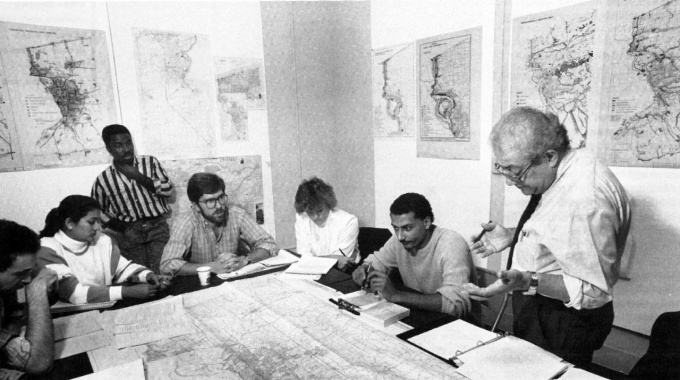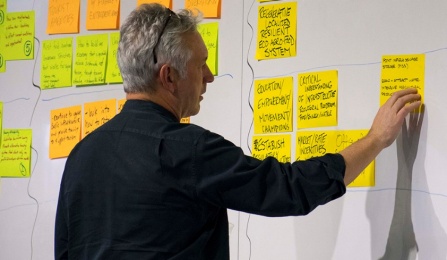The first 50 years

Ibrahim "Jimi" Jammal, one of the school's first faculty members in urban planning, with his students in Hayes Hall.
A culture of experimentation and innovation - then and now
Founded during the social, cultural and political tumult of the late 1960s, the "School of Architecture and Environmental Design," as it was then known, was viewed as a radical departure from traditional design education. UB's program taught architecture and planning in relation to its social and environmental conditions, and prepared community-minded citizens to engage design with the world's problems.
“It will not be a ‘school of architecture’ in the narrow sense, but will involve all that ‘environmental design’ implies.”
Over the course of the 2019-20 academic year, we will document the school's formative years and evolution over five decades - stories that reveal both an enduring drive behind our programs and persistent challenges facing education and practice in our professions.

Bradshaw Hovey is a research professor, writer and resident historian of the School of Architecture and Planning.
Behind the research and storytelling is our own faculty member Bradshaw Hovey. If you have stories, photos, documents or other archives you'd like to share, please contact Bradshaw at bhovey@buffalo.edu.
The founding principles of the school remain at the core of our mission: the pursuit of architecture, planning and real estate development as interdisciplinary problem-solving enterprises rooted in the needs of an increasingly diverse and complex urban world, animated by community of enterprising "makers" and "doers," and focused on research that transforms communities and the practice of our professions.
Over the years, intellectual fashions have made their mark on the life of the school. But some things have remained constant even as they have grown.
Research and teaching in service to the public
Students and faculty have always understood their work needed to embrace a continuous search for new knowledge about how our buildings, cities, and landscapes work, how they affect the lives of people and shape the environment, natural and human made. We have always strived to fulfill two interlocking principles: that research and teaching are almost always more effective when they happen in the context of practical, grounded work in the world and that our obligation to serve the community and society are well-met by exactly that same kind of work. In neighborhoods and districts in Buffalo and Niagara Falls, the Costa Rican cloud forest, or communities in the Global South, our faculty and students continue to serve as they learn.
We also embrace a culture of making. Architecture, environmental design, and planning are not abstract enterprises. They are manifest in real materials and forms. From the fascination of our early faculty with manufacturing affordable furniture out of hollow-core doors to recent work to marry high technology with the age old craft of terra cotta, we strive to make our dreams tangibly real.
Our global legacy
Through direct engagement with our local and global communities, the school has advanced impacts in regional development, state and federal policy making, global manufacturing, professional practice, and creative built works. Together we have taken on the world’s most complex social, environmental, and technological challenges, from poverty to food security to cybersecurity. Our local and global engagements have generated impacts as diverse as material innovation in Buffalo, global standards in universal design, and refugee settlement planning around the world.
Our nearly six thousand graduates are making an impact all over the nation, indeed the world, as well as in Buffalo Niagara. They lead architecture firms, serve as university faculty, drive planning consultancies, and lead the professions. But they also work in the arts, politics, management, information technology, and dozens of other fields. Founding Dean, John P. Eberhard, told students that an education in the School of Architecture and Planning wasn’t good only as training to be an architect or a planner. It would help them unlock many different careers, and it has.
These persistent principles and questions facing the School of Architecture and Planning endure. Indeed, as we enter the second half of our first century they are more important than ever.

